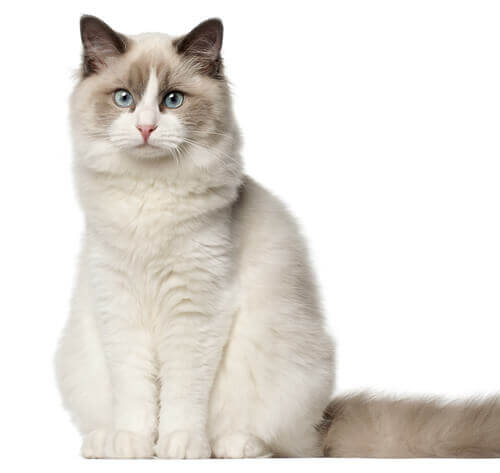
The Ragdoll is one of the most popular longhair cat breeds. Social and loving, this cat enjoys people and gets along well with children and dogs. The desire to be near her family has earned her the affectionate nickname “puppycat.” The Ragdoll can be taught to fetch and come when called. Playful throughout their lives, these cats mature slowly in three to four years.
DID YOU KNOW? The Ragdoll originated in the early 1960s when a Persian breeder, Ann Baker of Riverside, Calif., bred a semi-feral longhaired white cat resembling an Angora to cats she found or owned. The offspring of “Josephine” had unique, endearing temperament traits that Baker selectively bred in creating the breed.
The need-to-know
- Calm cat
- Sociable and dependent cat
- Quiet cat
- Larger stockier cat breed
- Requires grooming every day
- Non hypoallergenic breed
- Needs some out-door space
- Great family cat
Personality

The Ragdoll cat is possibly the most laid back of all the domestic cat breeds. These cats are basically content and undemanding and tolerate most situations. They have an extremely gentle and relaxed nature, and make loyal and devoted pets. There is an old-wives tale that these cats are immune to pain, but this is totally untrue! Their relaxed disposition stems from a very trusting nature, not a lack of feeling.
History and Origins

Country of Origin: USAThe first Ragdoll kittens were born in California in the 1960s. They are probably the result of a mating between a white Persian cat queen (female) and a Birman or Birman-type tom. When picked up the cat becomes very relaxed and is as floppy as the ragdoll from which it takes its name. There are some that say that this was brought about by an accident the queen had while carrying the kittens but it is genetically impossible for the effects of the injury to be inherited by the kittens.
Nutrition and Feeding

Every cat is unique and each has their own particular likes, dislikes, and needs when it comes to food. However, cats are carnivores and every cat must obtain 41 different and specific nutrients from their food. The proportion of these nutrients will vary depending on age, lifestyle and overall health, so it's not surprising that a growing, energetic kitten needs a different balance of nutrients in her diet than a less active senior cat. Other considerations to bear in mind are feeding the right quantity of food to maintain 'ideal body condition' in accordance with feeding guidelines and catering to individual preference regarding wet or dry food recipes.
Other Information

Health and common issues
The Ragdoll cat breed is associated with an inherited form of heart disease (hypertrophic cardiomyopathy) that can lead to heart failure at an early age – ask the breeder if you are considering buying this breed.
Best cat breeds for children
While this breed tends to be excellent with kids, each cat has a different personality based on training and life experience. Please consult the adoption organisation, if you are adopting, for details on a specific cats character.